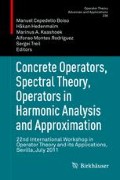Abstract
Suppose K y and K x are large sets of observed and reference signals, respectively, each containing N signals. Is it possible to construct a filter F : K y → K xthat requires a priori information only on few signals, p << N, from K x but performs better than the known filters based on a priori information on every reference signal from K x ? It is shown that the positive answer is achievable under quite unrestrictive assumptions. The device behind the proposed method is based on a special extension of the piecewise linear interpolation technique to the case of random signal sets. The proposed technique provides a single filter to process any signal from the arbitrarily large signal set. The filter is determined in terms of pseudo-inverse matrices so that it always exists.
Mathematics Subject Classification (2010). Primary 94A12; Secondary 65D05.
Access this chapter
Tax calculation will be finalised at checkout
Purchases are for personal use only
Preview
Unable to display preview. Download preview PDF.
References
J. Chen, J. Benesty, Y. Huang, and S. Doclo, New Insights Into the Noise Reduction Wiener Filter, IEEE Trans. on Audio, Speech, and Language Processing, 14, No. 4, pp. 1218–1234, 2006.
M. Spurbeck and P. Schreier, Causal Wiener filter banks for periodically correlated time series, Signal Processing, 87, 6, pp. 1179–1187, 2007.
J.S. Goldstein, I. Reed, and L.L. Scharf, “A Multistage Representation of the Wiener Filter Based on Orthogonal Projections,” IEEE Trans. on Information Theory, vol. 44, pp. 2943–2959, 1998.
Y. Hua, M. Nikpour, and P. Stoica, “Optimal Reduced-Rank estimation and filtering,” IEEE Trans. on Signal Processing, vol. 49, pp. 457–469, 2001.
A. Torokhti and P. Howlett, Computational Methods for Modelling of Nonlinear Systems, Elsevier, 2007.
E.D. Sontag, Polynomial Response Maps, Lecture Notes in Control and Information Sciences, 13, 1979.
S. Chen and S.A. Billings, Representation of non-linear systems: NARMAX model, Int. J. Control, vol. 49, no. 3, pp. 1013–1032, 1989.
V.J. Mathews and G.L. Sicuranza, Polynomial Signal Processing, J. Wiley & Sons, 2001.
A. Torokhti and P. Howlett, Optimal Transform Formed by a Combination of Nonlinear Operators: The Case of Data Dimensionality Reduction, IEEE Trans. on Signal Processing, 54, No. 4, pp. 1431–1444, 2006.
A. Torokhti and P. Howlett, Filtering and Compression for Infinite Sets of Stochastic Signals, Signal Processing, 89, pp. 291–304, 2009.
J. Vesma and T. Saramaki, Polynomial-Based Interpolation Filters – Part I: Filter Synthesis, Circuits, Systems, and Signal Processing, Volume 26, Number 2, Pages 115–146, 2007.
A. Torokhti and J. Manton, Generic Weighted Filtering of Stochastic Signals, IEEE Trans. on Signal Processing, 57, Issue 12, pp. 4675–4685, 2009.
A. Torokhti and S. Miklavcic, Data Compression under Constraints of Causality and Variable Finite Memory, Signal Processing, 90 , Issue 10, pp. 2822–2834, 2010.
I. Babuska, U. Banerjee, J.E. Osborn, Generalized finite element methods: main ideas, results, and perspective, International Journal of Computational Methods, 1 (1), pp. 67–103, 2004.
S. Kang and L. Chua, A global representation of multidimensional piecewise-linear functions with linear partitions, IEEE Trans. on Circuits and Systems, 25 Issue:11, pp. 938–940, 1978.
L.O. Chua and A.-C. Deng, Canonical piecewise-linear representation, IEEE Trans. on Circuits and Systems, 35 Issue:1, pp. 101–111, 1988.
J.-N. Lin and R. Unbehauen, Adaptive nonlinear digital filter with canonical piecewise-linear structure, IEEE Trans. on Circuits and Systems, 37 Issue:3, pp. 347–353, 1990.
J.-N. Lin and R. Unbehauen, Canonical piecewise-linear approximations, IEEE Trans. on Circuits and Systems I: Fundamental Theory and Applications, 39 Issue:8, pp. 697–699, 1992.
S.B. Gelfand and C.S. Ravishankar, A tree-structured piecewise linear adaptive filter, IEEE Trans. on Inf. Theory, 39, Issue 6, pp. 1907–1922, 1993.
E.A. Heredia and G.R. Arce, Piecewise linear system modeling based on a continuous threshold decomposition, IEEE Trans. on Signal Processing, 44 Issue:6, pp. 1440– 1453, 1996.
G. Feng, Robust filtering design of piecewise discrete time linear systems, IEEE Trans. on Signal Processing, 53 Issue:2, pp. 599 - 605, 2005.
F. Russo, Technique for image denoising based on adaptive piecewise linear filters and automatic parameter tuning, IEEE Trans. on Instrumentation and Measurement, 55, Issue:4, pp. 1362–1367, 2006.
J.E. Cousseau, J.L. Figueroa, S. Werner, T.I. Laakso, Efficient Nonlinear Wiener Model Identification Using a Complex-Valued Simplicial Canonical Piecewise Linear Filter, IEEE Trans. on Signal Processing, 55 Issue:5, pp. 1780–1792, 2007.
P. Julian, A. Desages, B. D’Amico, Orthonormal high-level canonical PWL functions with applications to model reduction, IEEE Trans. on Circuits and Systems I: Fundamental Theory and Applications, 47 Issue:5, pp. 702–712, 2000.
T. Wigren, Recursive Prediction Error Identification Using the Nonlinear Wiener Model, Automatica, 29, 4, pp. 1011–1025, 1993.
G.H. Golub and C.F. van Loan, Matrix Computations, Johns Hopkins University Press, Baltimore, 1996.
T. Anderson, An Introduction to Multivariate Statistical Analysis, New York, Wiley, 1984.
L.I. Perlovsky and T.L. Marzetta, Estimating a Covariance Matrix from Incomplete Realizations of a Random Vector, IEEE Trans. on Signal Processing, 40, pp. 2097– 2100, 1992.
O. Ledoit and M. Wolf, A well-conditioned estimator for large-dimensional covariance matrices, J. Multivariate Analysis 88, pp. 365–411, 2004.
Author information
Authors and Affiliations
Corresponding author
Editor information
Editors and Affiliations
Rights and permissions
Copyright information
© 2014 Springer Basel
About this paper
Cite this paper
Torokhti, A. (2014). Operator Approximation for Processing of Large Random Data Sets. In: Cepedello Boiso, M., Hedenmalm, H., Kaashoek, M., Montes Rodríguez, A., Treil, S. (eds) Concrete Operators, Spectral Theory, Operators in Harmonic Analysis and Approximation. Operator Theory: Advances and Applications, vol 236. Birkhäuser, Basel. https://doi.org/10.1007/978-3-0348-0648-0_31
Download citation
DOI: https://doi.org/10.1007/978-3-0348-0648-0_31
Published:
Publisher Name: Birkhäuser, Basel
Print ISBN: 978-3-0348-0647-3
Online ISBN: 978-3-0348-0648-0
eBook Packages: Mathematics and StatisticsMathematics and Statistics (R0)

